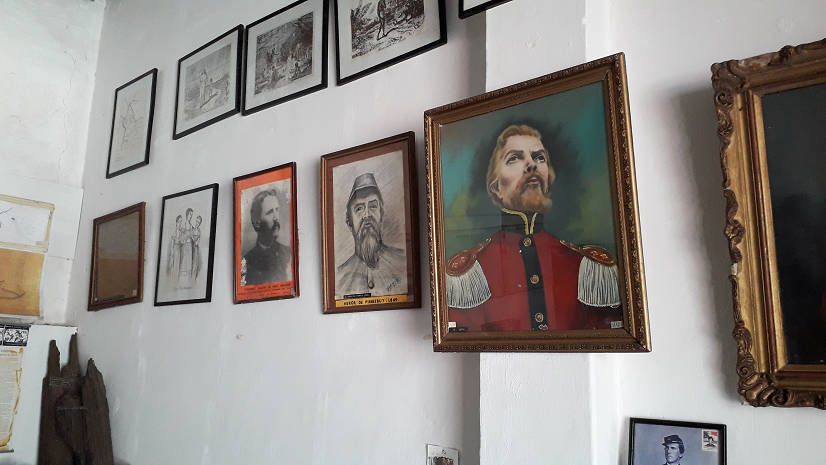Piribebuy is a small country town. These days it is mainly a destination for tourists seeking unspoiled countryside and green open spaces.
It does though have a long and interesting history. This is what is on show at the town museum.
The museum Comandente Pedro Pablo Cabellero is housed in a 19th century colonial style house just outside the town center.
It is located one block from the main plaza and the town church and directly in front of the modern council offices The building is a white washed single story building in the colonial style with a colonnaded veranda providing some shade in front.
For much of 2021 the museum was closed for refurbishments and renovations. It is now reopen with it’s displays now occupying the buildings two street facing rooms.
Outside the entrance is placed one of the museums more unusual artifacts. A small wooden cannon. This has stood guard in front of the doorway for many years. Despite rumors that it is a real cannon I am sure it was made solely for display.
Before I describe the interior of the museum a little bit of history as to how it came to be is required.
The town museum was originally opened in 1969. At that point however it had on display just religious art. It remained doing so for the next 25 years. Nothing more than another small museum containing local religious artifacts.
Then in 1994 it passed into the possession of a group of Chaco War veterans who turned it into a historical museum. The main focus of the museum then became the Chaco War in which they had fought and the battle of the Triple Alliance War which took place in Piribebuy.
That has remained the main focus of the museum every since and an interesting and important collection of historical items has found its way to the museum.
Following the refurbishing of the museum each now has its own room. The 19th century Battle of Piribebuy in the first and the 20th century Chaco War in the second.
The first room is dominated by paintings and images of the important figures both national and local in 19th century Paraguayan history. These range from the president right down to the local school master. The paintings fill one wall.
Mounted on another are a collection of maps. These show both national movements during the Triple Alliance War and the chronological events and troop actions during the Battle of Piribebuy on 12th August 1869.
Below the paintings and maps are displayed artifacts relating to the battle.
Displayed in a glass case are the remains of weapons and other metal artifacts recovered from the battle site.
Alongside are kept various pieces of timber and stonework taken from buildings that were damaged during the battle. These include a few timbers from the hospital that was burnt down during the battle and which has become the symbol of the battle and defeat in Piribebuy.
Finally in this room there are a few pieces of statuary. These all display the ravages of time but a large bust of the president is still in quite good condition.
Leading on from here a narrow doorway leads through to the second galley. This and dedicated to the Chaco War of 1932-35.
Here with everything being nearly a century more recent there are greater number of items on display. Some of them would not look out of place in a 2nd World War gallery.
A large glass cabinet is filled with the tools of war. Here there are bullets, grenades, knives and even a gas mask. The personal equipment of local soldiers.
Along with the weapons are more domestic items of equipment such as water flasks. A very important item in places as dry as the Chaco.
On the other side of the room also in a glass cabinet are uniforms. Green jackets in varying styles that would have been worm in battle.
Each of these has the name of the solider who once wore it recorded and one even has a photo. Piribebuy being a small town there will still be relatives and descendants of people who knew them living nearby. For the relatives especially a visit to the museum would be a very personal one.
Having then viewed everything I added my name to the visitors book as all who visit do. I then had time for a quick conversation with the keeper of the museum.
He has a great knowledge of everything contained within the museum and also about Piribebuy in general. Whatever questions visitors may have he can provide answers.
As for me although it had been several years since I had visited his museum he remembered me and knew exactly where my house was.
It is then only a small museum in a small town but one filled with history. Somewhere well worth a visit by anyone who happened to be in Piribebuy.


Please let me know if you’re looking for a article author for your site.
You have some really good posts and I believe I would be a good asset.
If you ever want to take some of the load off, I’d absolutely love to write some articles
for your blog in exchange for a link back to mine. Please blast me an email if interested.
Cheers!